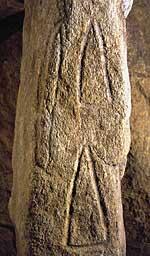- Home
- Discover the megaliths of Morbihan
- Art reflects the sacred
- Rock art
- Milestones
In Brittany, unlike in many areas of Europe, there are few traces of prehistoric natural rock art. However the region concentrates one of the finest sets of ornamented megalithic monuments in Europe, mostly around the Morbihan Gulf.
Most of the time, ornaments are either 'engraved' linear carvings (to be more precise, they were carefully pecked) or 'low relief', 'cut-away carving' patterns made by wearing away a more or less wide area around the decorative motif.
No real low-relief patterns (with clearly cut out parts) can be found. Volume sculptures are very rare indeed.
There are about twenty basic motifs, fifteen of which are recurrent. These motifs can have various shapes and can be represented alone or in association with others.
Although certain meaningful associations seem to exist, the combinations are too haphazard and irregular to be referred to as ideograms.
Studies carried out on ornamented monuments show that decorations were deliberately located. Still, analysis is by no means easy since ornamented (and sometimes even reshaped) slabs were used over and over again.
Four different kinds of motifs can be highlighted :
- 'ubiquitous' motifs, visible on all kinds of monuments,
- those linked to ancient passage tombs (some of which can also be found on menhirs),
- those represented on menhirs only (owing to frequent re-use, they can sometimes also be found on tombs)
- those associated with Late Neolithic gallery graves (and also with some menhirs).
The exceptional decoration displayed by Gavrinis illustrates how the art of the ancient passage tombs evolved. This art also influenced the elbow monuments (the "Pierres-plates" for instance) but not as many motifs were used (a single one in many instances).
As recent research has shown, ornamented menhirs are by no means as rare as they were once thought to be: in fact the decorative signs had either been damaged by bad weather or were hidden from view. Only a few signs seem to be specific to these menhirs, while the others appear in tombs as well (analogies with the Middle Neolithic elbow tombs or with the Late Neolithic gallery graves can therefore be found).
"Shield" from Barnenez (Finistère), showing light linear pecking.
"Axes" and "bow" from Barnenez (Finistère), showing emphasized linear carvings.
A "crosier" from the Petit-Mont in Arzon, showing "low relief" highlighted by pecking of the immediate surround, narrow and precise on the left, larger and less clear on the right.
Although exposed to weathering, the Grand-Menhir at Locmariaquer still dsiplays "cut-away" carving, preserved from the overall pecking of the monolith.



